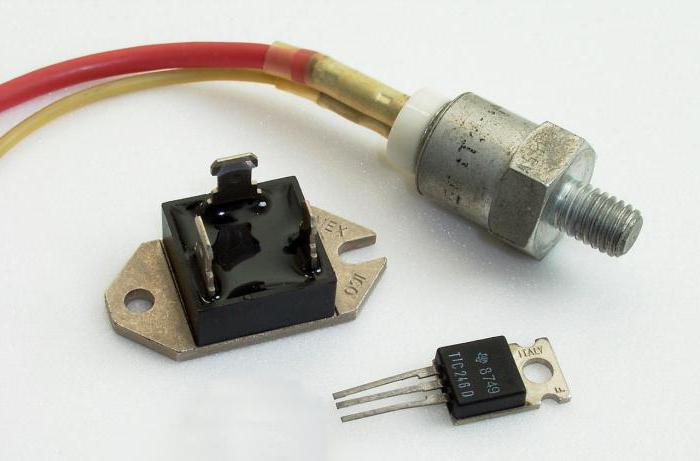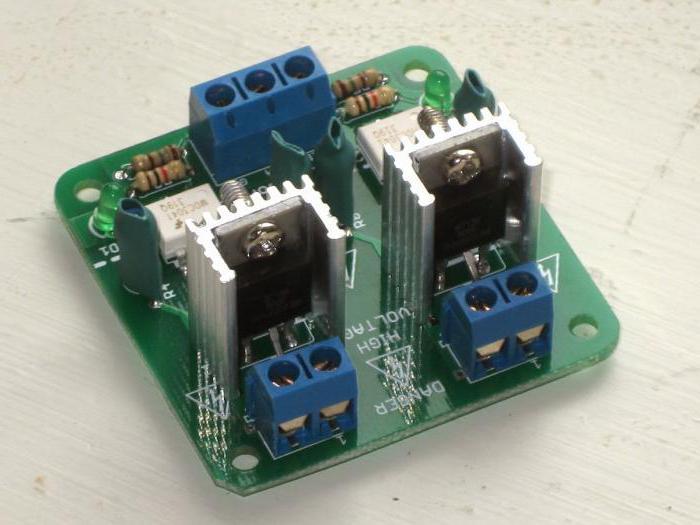From the article you will learn about what a triac is,principle of operation of this device, as well as features of its application. But first, it is worth mentioning that the triac is the same as the thyristor (only symmetrical). Consequently, the article does not do without a description of the principle of functioning of thyristors and their features. Without knowledge of the basics, it is impossible to design and build even the simplest control scheme.
Thyristors

Thyristor is a switching semiconductordevice that is able to pass current only in one direction. It is often called a valve and draw analogies between it and the controlled diode. Thyristors have three outputs, and one is the control electrode. This, to put it bluntly, is the button with which the element is switched to the conducting mode. The article will consider a special case of a thyristor - a triac - the device and its operation in various circuits.
Thyristor is also a rectifier, a switch andeven a signal booster. Often it is used as a regulator (but only in the case when the entire electrical circuit is powered from an alternating voltage source). All thyristors have some features that need to be discussed in more detail.
Thyristor properties

Among the huge variety of characteristics of this semiconductor element can be identified the most significant:
- Thyristors, like diodes, are capable of conducting electric current in only one direction. In this case, they work in a circuit like a rectifier diode.
- Из отключенного во включенное состояние тиристор can be transferred by applying a signal with a certain shape to the control electrode. Hence the conclusion - the thyristor, like a switch, has two states (both of which are stable). In the same way can function and triac. The principle of operation of an electronic type key based on it is quite simple. But in order to return to the original open state, it is necessary that certain conditions be met.
- Control signal current required forthe transition of a thyristor crystal from a locked to an open mode is much smaller than the worker (literally measured in milliamps). This means that the thyristor has the properties of a current amplifier.
- There is the possibility of fine adjustmentaverage current flowing through the connected load, provided that the load is connected to the thyristor in series. The accuracy of the adjustment depends on the duration of the signal on the control electrode. In this case, the thyristor acts as a power regulator.
Thyristor and its structure

Thyristor is a semiconductor element thathas control functions. The crystal consists of four layers of the p and n types, which alternate. The simistor is also built exactly. The principle of operation, application, structure of this element and restrictions on use are discussed in detail in the article.
The described structure is also called four-layer.The extreme region of the p-structure with the power supply pin connected to it of positive polarity is called the anode. Consequently, the second region n (also extreme) is the cathode. A negative voltage supply is applied to it.
What properties does a thyristor have?
If you conduct a complete analysis of the structure of the thyristor,then one can find in it three transitions (electron-hole). Consequently, it is possible to make an equivalent circuit on semiconductor transistors (polar, bipolar, field) and diodes, which will allow you to understand how the thyristor behaves when the control electrode is turned off.
In the case when relative to the cathode anodepositive, the diode is closed, and, therefore, the thyristor also behaves similarly. In the case of polarity reversal, both diodes are shifted, the thyristor is also locked. Similarly, and operates a triac.
The principle of work on the fingers, of course, is not very easy to explain, but we will try to do this further.
How does the thyristor unlock
To understand the principle of operation of the thyristor you needpay attention to the equivalent circuit. It can be composed of two semiconductor triodes (transistors). Here it is convenient to consider the process of unlocking thyristors. Some current is set which flows through the thyristor control electrode. In this case, the current has a forward bias. This current is considered to be the base for a transistor with the structure of pnp.
Поэтому в коллекторе ток у него будет больше в several times (you need to multiply the value of the control current by the gain of the transistor). Further, it can be seen that this current value is basic for the second transistor with the conduction structure pnr, and it is unlocked. In this case, the collector current of the second transistor will be equal to the product of the gains of both transistors and the initially specified control current. Triacs (the principle of operation and management of them are discussed in the article) have similar properties.
Further, this current must be summed up with earliergiven current control circuit. And that is exactly the value that is needed to keep the first transistor in the unlocked state. In the case when the control current is very large, the two transistors are simultaneously saturated. The internal OS continues to maintain its conductivity even when the initial current at the control electrode disappears. At the same time, a rather high current is detected at the anode of the thyristor.
How to disable the thyristor

The transition to the locked state of the thyristor is possible inIn the event that no signal is applied to the control electrode of the open element. In this case, the current drops to a certain value, which is called the hypostatic current (or holding current).
The thyristor will turn off even ifopen circuit in the load circuit. Or when the voltage that is applied to the circuit (external), changes its polarity. This occurs at the end of each half cycle in the case when the circuit is powered from the AC source.
When the thyristor is working in the DC circuit,locking can be done with a simple switch or a mechanical type button. It is connected to the load in series and is used to de-energize the circuit. The principle of operation of the power regulator on the triac is similar, however, there are some features in the diagram.
Ways to turn off thyristors
But you can connect the switch in parallel, thenit is used to shunt the anode current, and the thyristor is transferred to the locked state. Some types of thyristors can be switched on again if you open the switch contacts. This can be explained by the fact that during the opening of the contacts, the parasitic capacitances of the thyristor junctions accumulate charge, thereby creating interference.
Поэтому желательно располагать выключатель так, so that it is between the cathode and the control electrode. This will ensure that the thyristor turns off normally and the holding current is cut off. Sometimes, for convenience and to increase speed and reliability, an auxiliary thyristor is used instead of a mechanical key. It is worth noting that the work of the triac is in many respects similar to the functioning of the thyristors.
Triacs

And now closer to the topic of the article - you need to considerA special case of a thyristor is a triac. The principle of its operation is similar to what was considered earlier. But there are some differences and special features. Therefore, you need to talk about it in more detail. A triac is a device based on a semiconductor crystal. Very often used in systems that operate on alternating current.
Самое простое определение этого прибора – switch, but controlled. In the locked state, it works in exactly the same way as a circuit breaker with open contacts. When a signal is applied to the control electrode of the triac, the device enters the open state (conduction mode). When working in this mode, you can draw a parallel with the switch, whose contacts are closed.
When there is no signal in the control circuit,any of the half-periods (when working in AC circuits) triac transitions from open to closed. Triacs are widely used in the on-off mode (for example, in the construction of photosensitive switches or thermostats). But they are also often used in control systems that operate according to the principles of phase control of the voltage across the load (they are smooth regulators).
The structure and principle of operation of the triac

Triac is nothing but symmetricalthyristor. Therefore, based on the name, it can be concluded - it is easy to replace it with two thyristors, which are included in anti-parallel. In any direction, it can pass a current. The triac has three main outputs - the control, for supplying signals, and the main ones (anode, cathode), so that it can pass operating currents.
Симистор (принцип работы для "чайников" этого semiconductor element provided to your attention) opens when the minimum required current value is applied to the control output. Or in the case when between two other electrodes the potential difference is higher than the maximum permissible value.
В большинстве случаев превышение напряжения leads to the fact that the triac spontaneously operates at the maximum amplitude of the supply voltage. The transition to the locked state occurs in case of a change in polarity or when the operating current decreases to a level lower than the holding current.
How is the triac unlocked

When powered by AC power occurschange of operating modes due to a change in polarity of the voltage on the working electrodes. For this reason, depending on the polarity of the control current, 4 types of this procedure can be distinguished.
Допустим, между рабочими электродами приложено voltage. And on the control electrode, the voltage across the sign is opposite to that applied to the anode circuit. In this case, the triac will shift along the quadrant — the principle of operation, as you can see, is quite simple.
There are 4 quadrants, and for each of themdefined unlock current, holding, turn on. The unlocking current must be maintained for as long as it does not exceed several times (2-3) it is the value of the holding current. This is exactly the triac switching current - the minimum required unlocking current. If you get rid of the current in the control circuit, the triac will be in a conducting state. Moreover, it will work in this mode for as long as the current in the anode circuit is greater than the holding current.
What are the restrictions when using triacs
It is difficult to use when the loadinductive type. The rate of change of voltage and current is limited. When the triac goes from locked to open mode, a significant amount of current occurs in the external circuit. The voltage does not fall instantly on the power outputs of the triac. And the power will instantly develop and reaches quite large quantities. The energy that is dissipated due to the small space dramatically increases the temperature of the semiconductor.
В случае превышения критического значения the destruction of the crystal occurs due to an excessively rapid increase in the strength of the current. If some voltage is applied to the triac, which is in the locked state, and it is increased sharply, the channel will open (if there is no signal in the control circuit). This phenomenon can be observed for the reason that the charge accumulates by the internal parasitic capacitance of the semiconductor. Moreover, the charge current is sufficient to unlock the triac.








